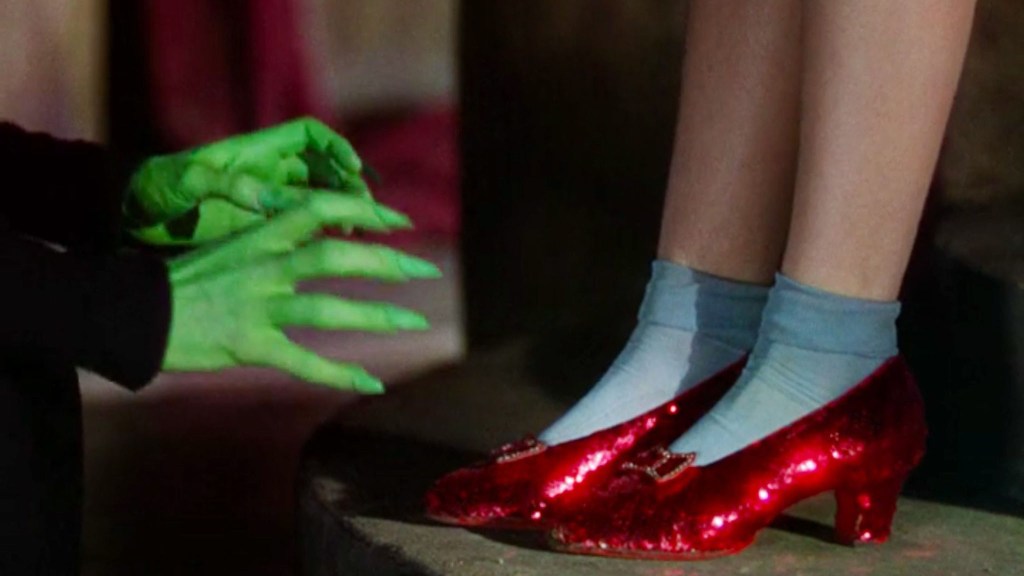Think those legendary ruby slippers from The Wizard of Oz are making a comeback in the new Wicked movie? Think again. In a dazzling twist, Dorothy’s famous footwear has undergone a striking metamorphosis, trading their crimson sparkle for a shimmering silver sheen. But this isn’t just another Hollywood reimagining—it’s actually a return to the original vision that started it all.
Videos by ComicBook.com
When the first glimpses of Wicked hit screens in its theatrical trailers, eagle-eyed fans noticed something distinctly different about the iconic shoes. The transformation isn’t merely aesthetic—it’s a deliberate choice that speaks volumes about the filmmakers’ commitment to literary authenticity and their bold vision for this prequel to the beloved tale we all know.
L. Frank Baum‘s original 1900 novel The Wonderful Wizard of Oz never featured ruby slippers at all. Instead, as costume designer Paul Tazewell explained to PEOPLE magazine, “In the book, they were these odd little silver boots.” This seemingly simple detail unveils a century-old deviation that occurred when MGM adapted the story for the screen in 1939.
[RELATED: Stolen Ruby Slippers From The Wizard of Oz Have Been Recovered by FBI]
The shift from silver to ruby in the iconic film wasn’t arbitrary, however. It was the The Wizard of Oz’s screenwriter, Noel Langley, who proposed the color change. The motivation? MGM wanted to capitalize on their groundbreaking use of Technicolor’s three-strip film technology—a revolutionary advancement in an era dominated by black-and-white cinema. The ruby red created a stunning visual contrast against the yellow brick road, transforming the shoes into an unforgettable cinema icon.
The creation and legacy of the original ruby slippers represent one of Hollywood’s most fascinating stories. Costume designer Adrian Adolph Greenburg, known professionally as Adrian, initially experimented with different designs. His first attempt featured a curled “Aladdin” toe, but this was ultimately rejected for clashing with Dorothy’s farm girl character.

The final design—those beloved bow-adorned red satin shoes—required some engineering adjustments. Initially decorated with heavy bugle beads, they were eventually reimagined with 2,300 sequins to achieve the perfect balance of sparkle and wearability.
The exact number of pairs created for the 1939 film remains a mystery, but five authenticated pairs have survived to the present day. These precious artifacts of cinema history have followed remarkable journeys. One pair resides in the Smithsonian’s American Museum of Natural History in Washington, D.C., while another found its home at the Academy Museum of Motion Pictures in Los Angeles, thanks to support from Hollywood celebrities like Leonardo DiCaprio and Steven Spielberg. A third is currently up for auction after having been stolen nearly 20 years ago.
For the 2024 adaptation of Wicked, costume designer Paul Tazewell faced an intriguing challenge: how to honor both the original source material and create something fresh for modern audiences. His solution? It was a groundbreaking design, merging historical inspiration with contemporary innovation.
“They needed to resonate in an iconic way, like the ruby slipper,” Tazewell told WWD. “I wanted for it to not just be another ruby slipper, but to be specific to the world we were creating.”
Tazewell collaborated with artisan Miodrag Guberinic to create what they’ve dubbed the “jeweled shoes.” These unique footwear pieces feature an intricate spiral design that cleverly references the tornado—the natural phenomenon that famously transported Dorothy to Oz.
“I have the heel starting as a tornado of jewels that swirls up and then wraps over the foot, and swirls around the foot,” Tazewell described to the outlet. The shoes were brought to life through 3D printing technology and adorned with 1,165 Preciosa crystals, marking a perfect marriage between traditional craftsmanship and modern manufacturing techniques.
The silver shoes in Wicked aren’t just a nod to Baum’s original work, either—they’re also deeply rooted in Gregory Maguire’s 1995 novel Wicked: The Life and Times of the Wicked Witch of the West. Maguire maintained fidelity to Baum’s vision, describing the footwear as iridescent beaded shoes gifted to Nessarose, who later becomes the Wicked Witch of the East.
In Maguire’s telling, these silver shoes gain their magical properties through Glinda’s enchantment, enabling the wheelchair-bound Nessarose to walk. The Broadway adaptation tweaked this detail, making Elphaba the source of the magical transformation. This evolution of the story demonstrates how the shoes have become more than mere accessories—they’re powerful symbols of transformation and empowerment.
The dual identity of Dorothy’s famous footwear—sometimes ruby, sometimes silver—reflects the diversity of Oz’s various interpretations across different media. The color shift in Wicked isn’t just a casual change but potentially ties into a crucial third-act revelation that explains the transformation from silver to ruby.
The silver shoes might initially seem jarring for modern audiences primarily familiar with the 1939 film. However, this attention to the source material should inspire confidence in the adaptation’s commitment to authenticity. The decision to return to silver represents a broader philosophical approach to the material that honors the story’s roots while crafting something new.
With Wicked‘s recent release in theaters, audiences will witness this fresh interpretation of one of literature’s most famous pairs of shoes. The silver shoes will appear again in the sequel, scheduled for 2025, suggesting their significance extends beyond mere costume design to become an integral part of this new chapter in the Oz saga.
Wicked is playing in theaters now.








![Simu Liu Confirms The 2 Dream X-Men Shang-Chi Works With On Avengers: Doomsday [Exclusive]](https://comicbook.com/wp-content/uploads/sites/4/2025/12/Simu-Liu-Avengers-Doomsday-interview.jpg?w=300)